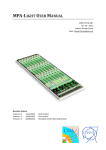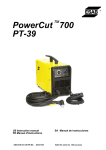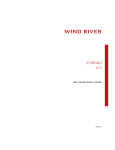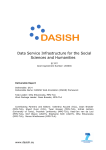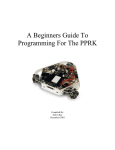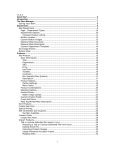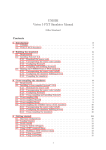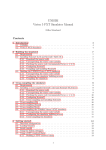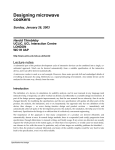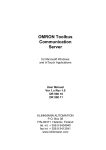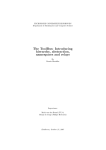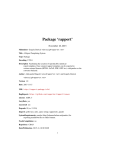Download A Language Development Environment for Eclipse
Transcript
A Language Development
Environment
for Eclipse
A.T. Kooiker
January 2004
Master’s Thesis in Computer Science
Programming Research Group
Faculty of Science
University of Amsterdam
Supervisors: prof. dr. P. Klint, drs. H.A. de Jong
2
Contents
1 Introduction
1.1 General . . . . . . . . . . . . . . . . . . . . . . . . . . . . . . . .
1.2 Acknowledgements . . . . . . . . . . . . . . . . . . . . . . . . . .
2 A Language Development Environment for
2.1 Introduction . . . . . . . . . . . . . . . . . .
2.1.1 Eclipse Plugin Technology . . . . . .
2.1.2 Meta-Environment Technology . . .
2.2 Architectural considerations . . . . . . . . .
2.3 Implementation . . . . . . . . . . . . . . . .
2.3.1 JFC/Swing-based implementation .
2.3.2 Eclipse-based implementation . . . .
2.4 Lessons learned . . . . . . . . . . . . . . . .
2.4.1 Meta-Environment issues . . . . . .
2.4.2 Eclipse issues . . . . . . . . . . . . .
2.5 Conclusions . . . . . . . . . . . . . . . . . .
Eclipse
. . . . .
. . . . .
. . . . .
. . . . .
. . . . .
. . . . .
. . . . .
. . . . .
. . . . .
. . . . .
. . . . .
.
.
.
.
.
.
.
.
.
.
.
.
.
.
.
.
.
.
.
.
.
.
.
.
.
.
.
.
.
.
.
.
.
.
.
.
.
.
.
.
.
.
.
.
.
.
.
.
.
.
.
.
.
.
.
.
.
.
.
.
.
.
.
.
.
.
.
.
.
.
.
.
.
.
.
.
.
5
5
6
7
7
8
8
9
10
10
11
11
11
12
14
3 Asf+Sdf Meta-Environment
15
3.1 Introduction . . . . . . . . . . . . . . . . . . . . . . . . . . . . . . 15
3.2 Graphical User Interface and Editors . . . . . . . . . . . . . . . . 16
4 ToolBus
4.1 Introduction . . . . . . . . . . . . . . .
4.2 ToolBus coordination: processes . .
4.3 ToolBus computation: tools . . . . .
4.4 The ToolBus and Eclipse . . . . . .
4.4.1 Solution 1: Two JavaAdapters
4.4.2 Solution 2: Proxy ToolBus .
.
.
.
.
.
.
.
.
.
.
.
.
.
.
.
.
.
.
.
.
.
.
.
.
.
.
.
.
.
.
.
.
.
.
.
.
.
.
.
.
.
.
.
.
.
.
.
.
.
.
.
.
.
.
.
.
.
.
.
.
.
.
.
.
.
.
17
17
17
18
18
19
19
5 Connecting Eclipse to the Meta-Environment
5.1 Introduction . . . . . . . . . . . . . . . . . . . .
5.2 Editors and the Meta-Environment . . . . . . .
5.2.1 Editor Manager . . . . . . . . . . . . . .
5.2.2 Editor Hive . . . . . . . . . . . . . . . .
5.3 Proxy ToolBus . . . . . . . . . . . . . . . . .
5.3.1 Stub process . . . . . . . . . . . . . . .
5.3.2 Merging processes . . . . . . . . . . . .
5.4 TransAdapter . . . . . . . . . . . . . . . . . . .
.
.
.
.
.
.
.
.
.
.
.
.
.
.
.
.
.
.
.
.
.
.
.
.
.
.
.
.
.
.
.
.
.
.
.
.
.
.
.
.
.
.
.
.
.
.
.
.
.
.
.
.
.
.
.
.
.
.
.
.
.
.
.
.
.
.
.
.
.
.
.
.
.
.
.
.
.
.
.
.
21
21
21
22
22
23
23
24
25
3
.
.
.
.
.
.
.
.
.
.
.
.
.
.
.
.
.
.
.
.
.
.
.
.
4
CONTENTS
5.5
TransAdapter protocol . . . . . . .
5.5.1 snd-do messages . . . . . .
5.5.2 Transformation of snd-eval
5.5.3 Transformation of rec-event
.
.
.
.
.
.
.
.
.
.
.
.
.
.
.
.
.
.
.
.
.
.
.
.
.
.
.
.
.
.
.
.
.
.
.
.
.
.
.
.
.
.
.
.
.
.
.
.
.
.
.
.
.
.
.
.
.
.
.
.
.
.
.
.
.
.
.
.
26
26
27
28
6 Eclipse Meta Plugin
6.1 Introduction . . . . . . . . . . .
6.2 Plugin.xml . . . . . . . . . . .
6.3 Meta-Environment Perspective
6.3.1 Resource Navigator . . .
6.3.2 Module Explorer . . . .
6.3.3 Graph Views . . . . . .
6.4 Editor . . . . . . . . . . . . . .
.
.
.
.
.
.
.
.
.
.
.
.
.
.
.
.
.
.
.
.
.
.
.
.
.
.
.
.
.
.
.
.
.
.
.
.
.
.
.
.
.
.
.
.
.
.
.
.
.
.
.
.
.
.
.
.
.
.
.
.
.
.
.
.
.
.
.
.
.
.
.
.
.
.
.
.
.
.
.
.
.
.
.
.
.
.
.
.
.
.
.
.
.
.
.
.
.
.
.
.
.
.
.
.
.
.
.
.
.
.
.
.
.
.
.
.
.
.
.
.
.
.
.
.
.
.
.
.
.
.
.
.
.
29
29
29
30
30
32
33
34
7 Conclusions and Future Work
7.1 Conclusions . . . . . . . . . .
7.2 Syntax Highlighting . . . . .
7.3 Help Facilities . . . . . . . . .
7.4 Other . . . . . . . . . . . . .
.
.
.
.
.
.
.
.
.
.
.
.
.
.
.
.
.
.
.
.
.
.
.
.
.
.
.
.
.
.
.
.
.
.
.
.
.
.
.
.
.
.
.
.
.
.
.
.
.
.
.
.
.
.
.
.
.
.
.
.
.
.
.
.
.
.
.
.
.
.
.
.
.
.
.
.
35
35
36
36
36
.
.
.
.
A The merged process
39
B The user interface idef
41
C The editor hive idef
45
Chapter 1
Introduction
1.1
General
The Asf+Sdf Meta-Environment is an interactive development environment
with an graphical user interface written in JFC/Swing. A typical session in
this environment results in an overwhelming amount of windows presenting the
Meta-Environment itself next to lots of editors all trying to catch the attention
of the user. Although the described scene is a little bit exaggerated the several
open windows and JFC/Swing graphical user interface were the reasons to take
a look into Eclipse.
Eclipse is a framework for creating programming environments, wherefore
currently versions are available for C / C++, java and Cobol. Each version addresses a specific programming language with its own set of tools, commands and
screen layout. Because Eclipse is a well developed environment the Asf+Sdf
Meta-Environment could benefit from integration with Eclipse. Eclipse offers
the possibility to make your own perspective (which is a screen layout) consisting
of tree views, editors and other kind of views all in one place.
Eclipse on the other side can benefit from the integration with the MetaEnvironment because the Meta-Environment brings generic language technology to Eclipse. Instead of developing a development environment for each programming language one development environment for the Meta-Environment
is enough to provide tools for every programming language developed in the
Meta-Environment.
Chapter 2 covers the results of the integration of the Meta-Environment with
Eclipse. This chapter has been presented at the Eclipse workshop at OOPSLA
2004 and is being published in the ACM Digital Library1 . To be able to understand what has to be done to integrate the Meta-Environment with Eclipse
a brief introduction to both the Meta-Environment (see Chapter 3) and the
underlying ToolBus technology (see Chapter 4) will be given. The technical
details of the Eclipse Meta Plugin will be explained in Chapters 5 and 6.
1 Available
at portal.acm.org/dl.cfm
5
6
1.2
CHAPTER 1. INTRODUCTION
Acknowledgements
Writing a thesis is not an everyday task you can do on your own. Therefore I
would like to thank the following people:
My parents for supporting me during all these years and giving me the chance
to study Computer Science.
Wendy, although telling me that I did the job, she was the one that made me
realize I had to finish it.
Paul Klint for giving me the possibility to work in a nice research environment
with friendly colleagues and for letting me visit the OOPSLA 2003 conference
in Los Angeles. It was a great experience!
Hayco, for sharing lots of fun next to some serious pair programming and
supporting me in The States (which was needed, especially after someone said
the nice 25 person room changed that morning to a room for 80 people).
Furthermore thanks to Mark van den Brand and Jurgen Vinju for answering
all questions I had. One fool can ask more than Mark and Jurgen can answer.
Chapter 2
A Language Development
Environment for Eclipse
The Asf+Sdf Meta-Environment provides a collection of tools for the generation of programming environments. We show how Eclipse can be extended
with these generic language tools. By integrating the GUI and text editor of the
Meta-Environment with Eclipse using ToolBus technology, we demonstrate the
integration of third party, non-java, software in Eclipse. By doing so, we create
an experimentation framework for further programming language research. We
describe our experiences and sketch future work.
2.1
Introduction
Eclipse [7] is an open source framework for creating programming environments.
Currently versions exist for C / C++1 , java and Cobol2 . New tools and languages can be added by writing java applications that perform parsing, type
checking and the like for a new language. Eclipse provides a rich set of tools
oriented toward user-interface construction and java compilation. The level of
automation for building environments for new languages is, however, low.
The Asf+Sdf Meta-Environment [3, 6] is a programming environments
generator: given a language definition consisting of a syntax definition (grammar) and tool descriptions (using rewrite rules) a language specific environment
is generated. A language definition typically includes such features as pretty
printing, type checking, analysis, transformation and execution of programs in
the target language. The Asf+Sdf Meta-Environment is used to create tools
for domain-specific languages and for the analysis and transformation of software systems.
As the Eclipse and Meta-Environment technologies are to a large extent
complementary, it is worthwhile to investigate how they can be integrated.
1 Available
2 Available
at www.eclipse.org/cdt
at www.eclipse.org/cobol
7
8CHAPTER 2. A LANGUAGE DEVELOPMENT ENVIRONMENT FOR ECLIPSE
2.1.1
Eclipse Plugin Technology
The Eclipse Platform is designed for building integrated development environments (IDEs) [7]. An IDE can be built by providing the Eclipse Platform with
a plugin contributing to an extension point of some other plugin. In fact the
Eclipse Platform is a number of plugins itself. It consists of a small kernel which
starts all necessary plugins to run a basic instance of the Eclipse Platform. All
other functionality is located in plugins which extend these basic plugins. In this
way Eclipse provides tool providers with a mechanism that leads to seamlessly
integrated tools.
Eclipse plugins are written in java and consist of a manifest file and java
classes in a JAR archive. The manifest file declares the extension points of the
plugin and which other plugins it extends. On start-up the Eclipse Platform
discovers which plugins are available and it generates a plugin registry. The
plugin itself is loaded when it actually needs to be run.
2.1.2
Meta-Environment Technology
The Asf+Sdf formalism [1, 4] is used for the definition of syntactic as well
as semantic aspects of a language. It can be used for the definition of a range
of languages (for programming, writing specifications, querying databases, text
processing, or other applications). In addition it can be used for the formal
specification of a wide variety of problems. Asf+Sdf can be characterized as a
modular, rewriting-based, specification formalism in which syntax and semantics
are completely integrated.
The Asf+Sdf Meta-Environment is both a programming environment for
Asf+Sdf specifications and a programming environment generator which uses
an Asf+Sdf specification for some (programming) language L to generate a
stand-alone environment for L. The design of the Meta-Environment is based
on openness, reuse, and extensibility. The Meta-Environment offers syntaxdirected editing of Asf+Sdf specifications as well as compilation of Asf+Sdf
specifications into dedicated interactive stand-alone environments containing
various tools such as a parser, unparser, syntax-directed editor, debugger, and
interpreter or compiler.
Figure 2.1 shows the user interface developed using JFC/Swing. This figure
shows the modular structure of the specification. Each node in the graph can
be clicked and allows the invocation of a syntax, equation, or term editor.
The various types of editors are decorated with different pull-down menus.
All editors have functionality to invoke the parser, view the parse tree of the
focus as graph, and to move the focus. Term editors may have language specific
pull-down menus.
In order to achieve a strict separation between coordination and computation
we use the ToolBus coordination architecture [2], a programmable software bus
based on process algebra. Coordination is expressed by a formal description of
the cooperation protocol between components while computation is expressed
in components that may be written in any language. We thus obtain interoperability of heterogeneous components in a (possibly) distributed system. The
components are not allowed to communicate directly with each other, but only
via the ToolBus. This leads to a rigorous separation of concerns.
2.2. ARCHITECTURAL CONSIDERATIONS
9
Figure 2.1: The Meta-Environment GUI.
2.2
Architectural considerations
The Meta-Environment consists of about 20 cooperating components, including
a parsetable generator, a parser and unparser, a term store (for caching results),
and an interpreter and compiler. Also, a graphical user interface and a number
of text editors (such as GNU Emacs3 and Vim4 ) as well as a structure editor
are connected to the Meta-Environment. These allow user interaction with
the system, and in particular allow users to edit syntax, equations and terms.
Figure 2.2 is a (simplified) view showing these components connected to the
ToolBus.
Current architecture: using JFC/Swing and external editors. Figure 2.2 shows the current implementation with separate components for the GUI
and the various text editors. Currently, the GUI is implemented in JFC/Swing.
Each time a text editing session is requested by the user, a new instance of one
of the supported system editors is executed to take care of the editing session.
These text editors need only implement a minimal interface to be usable by the
Meta-Environment. Some form of operating system level communication channel is needed (e.g. socket, pipe). The editor then needs to be able to receive and
execute commands to add a menu to the menu-bar, set the cursor at a specific
location, and highlight or select a region of text.
3 Available
4 Available
at www.gnu.org/software/emacs
at www.vim.org
10CHAPTER 2. A LANGUAGE DEVELOPMENT ENVIRONMENT FOR ECLIPSE
Figure 2.2: Architecture of the Meta-Environment using the ToolBus.
Target architecture: using Eclipse for both GUI and editors. Eclipse
exports many GUI features that can be used to write plugins and also has a
built-in editor which implements the required Meta-Environment text editor
interface. From an Eclipse point of view, it is interesting to be able to reuse
the generic language technology offered by the Meta-Environment. From the
Meta-Environment point of view, it would be interesting to see if Eclipse could
be used to implement the GUI and the text editors (the dotted rectangle in
Figure 2.2). From a ToolBus point of view, it is interesting to see how a
single tool (Eclipse in this case) can serve as the implementation of multiple
components (both GUI and text editor).
2.3
Implementation
In Section 2.3.1 we describe some of the implementation details of the current
Meta-Environment GUI.
In the target architecture we replace both the JFC/Swing GUI and the
external text editors by Eclipse as described in Section 2.3.2.
2.3.1
JFC/Swing-based implementation
The ToolBus principle to separate functionality leads to a generic implementation of the user interface. To meet the Meta-Environment requirements the
user interface only has to implement some basic functionality. The JFC/Swing
implementation extends the Meta-Environment with a GUI that supports several components: a tree panel, graph panel, and some informational panels.
The tree and graph panels provide the user with a representation of opened and
imported modules in a textual and graphical way, respectively. Status messages
and information about selected modules are displayed in dedicated informational panels. Each of these GUI elements is dumb: it is capable of presenting
a graphical representation of its data and it communicates events (e.g. a mouse
click) to the ToolBus, but it abstracts from the details of these events. The
2.4. LESSONS LEARNED
11
actual implementation of an event (e.g. performing a refactoring operation on
a selected module) is handled elsewhere in the Meta-Environment.
The provided basic framework can be extended dynamically with user interface elements by means of ToolBus messages sent to the user interface. These
messages contain the type of user interface element to be added (e.g. menu,
tool-bar button), the caption to be displayed, and the action that has to be
performed when selecting this user interface element. This setup ensures that
the user interface does not know about any functionality implemented in the
Meta-Environment.
Text editing functionality is provided by means of external text editors as
described before. In general the choice of text editor is free as long as it is
capable of adding menus and methods for displaying a focus. After connection
with the ToolBus is established it will receive its specific menus, menu items,
and corresponding actions.
2.3.2
Eclipse-based implementation
In order to use Eclipse for the implementation of the Meta-Environment GUI
and text editor, we adapt the Meta-Environment architecture as shown in Figure 2.3. In a ToolBus setting external tools (such as a GUI and text editor) are
rigorously separated components which never directly communicate with each
other, but always do so via the ToolBus. In order to connect Eclipse (a single
operating system level component) to the Meta-Environment, we use a second
ToolBus which acts as a proxy between the Meta-Environment on one side,
and the actual implementations of the GUI and text editor in Eclipse on the
other. This second ToolBus, together with two instances of a transparent stub
(one for the GUI and one for the text editor) takes care of any (de-)marshalling
and forwarding from the Meta-Environment to Eclipse and back.
The Eclipse Meta plugin is implemented as an Eclipse perspective, containing extensions of an explorer (to display the modules), several views (e.g. to
display status messages) and instances of an extension of the built-in editor.
The perspective itself takes care of setting up a connection to the ToolBus
before instantiating the other Eclipse view parts which receive their operational
details from the ToolBus. Figure 2.4 shows the Eclipse user interface of the
Meta-Environment.
2.4
Lessons learned
We have identified several opportunities for improvement in both the JFC/Swing
Meta-Environment (Section 2.4.1) as well as in Eclipse (Section 2.4.2).
2.4.1
Meta-Environment issues
Complex editor management. Before we started integrating the MetaEnvironment and Eclipse, all text editor management was handled in several
ToolBus processes. For each editing session, the ToolBus invoked a new
instance of the system editor. This conflicted with Eclipse, because Eclipse already handles multiple editor instances itself. Since the original setup was quite
complex, we decided to encapsulate this complexity in a separate tool. The
12CHAPTER 2. A LANGUAGE DEVELOPMENT ENVIRONMENT FOR ECLIPSE
Figure 2.3: Eclipse as implementation of the GUI and text editors.
JFC/Swing implementation now uses this tool, the Eclipse setting handles the
editor management inside Eclipse itself.
2.4.2
Eclipse issues
Most of the Meta-Environment functionality present in the JFC/Swing version
was implemented equally well in the Eclipse version, but we did encounter some
difficulties which we would hope to see eliminated in a future version of Eclipse.
No support for File Open dialog. An important difference between the
current Meta-Environment and Eclipse is exposed when we consider how to
open new modules. The current JFC/Swing implementation delegates open
module events to the ToolBus, where other processes subsequently ask for the
instantiation in the GUI of a “File Open” dialog to ask the user for the name of
the module to be opened. Because Eclipse does not have such a dialog, we had
to implement the opening of modules quite differently. The user first selects a
file in the module explorer, and then hits the open module button. This causes
the order of user interaction in Eclipse (select file, hit button) to be the opposite
of the original order in JFC/Swing (hit button, select file).
No access to files outside workspace. Eclipse only allows access to files
residing in the workspace. Files outside the workspace first need to be imported into the workspace, before they can be used. However, when the MetaEnvironment uses a module, it also needs the transitive closure of its imported
2.4. LESSONS LEARNED
13
Figure 2.4: The Meta-Environment in Eclipse.
modules which are not necessarily located in the workspace (they could be anywhere on the file system). As a consequence, a user cannot edit any module
that is not part of the workspace.
Plugin configurability too rigid. The plugin manifest file is not usually
edited by plugin users. One of the things that is hard coded in this manifest, is the link between file extension and corresponding editor to be used in
Eclipse when such a file needs to be edited. Because the Meta-Environment
has no fixed language, and file extensions are often associated with a particular, new, language, an explicit link between each developed language and the
Meta-Environment plugin editor has to be inserted in the manifest manually.
Workbench state management too Eclipse centric Eclipse keeps track
of the state of the workbench. There is no flexibility when an external tool
also needs to maintain a portion of this state. This interferes with the way
the Meta-Environment operates. Upon Eclipse startup, views from a previous
session are still present in the workbench, but they do not have the state from
the previous session. Most notably, any connection to the ToolBus is lost,
and in fact, the rest of the Meta-Environment components may not even have
been started yet. A Perspective.close() method (not yet available, as other
plugin writers have noted in the Eclipse newsgroups) would already have been
useful, as it would have allowed us to simply close any view that is managed by
the Meta-Environment.
14CHAPTER 2. A LANGUAGE DEVELOPMENT ENVIRONMENT FOR ECLIPSE
2.5
Conclusions
The main contributions of this work are as follows:
• A proof-of-concept connection between Eclipse and the Meta-Environment:
this extends Eclipse with language definition tools and extends the MetaEnvironment with richer user-interface functionality.
• The ToolBus provides a general mechanism for connecting non-java
tools to Eclipse.
• We have pinpointed several issues of possible improvement in both systems.
The presented Eclipse Meta Plugin consists of a user interface and text editing
capabilities as already provided by the JFC/Swing Meta-Environment. Through
the Eclipse user interface, all generators of the Meta-Environment are available.
We plan to work on extending each system by integrating functionality from
the other one. On the one hand, Eclipse provides functionality for on-line help,
documentation and error reporting. All these can be borrowed by the Asf+Sdf
Meta-Environment.
On the other hand, we are currently integrating the Meta-Environment’s
graph viewer into Eclipse. Other useful functionality is apigen [5] which generates application program interfaces in C and java from a grammar definition.
This might make Eclipse further open for non-java tools.
The integration experiment we described in this paper shows that the combination Eclipse/Asf+Sdf Meta-Environment creates a versatile experimentation platform for programming language research.
Chapter 3
Asf+Sdf
Meta-Environment
The Asf+Sdf Meta-Environment is an interactive development environment
for the automatic generation of interactive systems for the construction of language definitions. Understanding what this means and what can be done with
the Asf+Sdf Meta-Environment is needed to make integration with Eclipse
possible.
3.1
Introduction
The Asf+Sdf Meta-Environment is an interactive development environment
for the automatic generation of interactive systems for the construction of language definitions. After a language definition has been constructed, tools for
this language can be generated (e.g. parser, type checker, and compiler). A
language definition typically consists of a syntax (sdf) and a semantics (asf)
definition. The Asf+Sdf Meta-Environment can help in:
• Writing a formal specification for some problem where interactive support
is needed.
• Developing programming languages and creating an interactive environment for it.
• Analyzing or transforming programs in some existing programming language.
Using the Meta-Environment new specifications can be made, specifications
can be modified and, using terms, existing specifications can be tested. A
language specification consists of modules which can be edited by invoking an
external editor. These modules consist on their turn of the aforementioned
syntax and semantics (equations) part.
The Asf+Sdf Meta-Environment consists of about 25 components that are
connected via the ToolBus which will be discussed in Chapter 4. Figure 3.1
shows the basic architecture with some of the most important components.
15
16
CHAPTER 3. ASF+SDF META-ENVIRONMENT
Figure 3.1: Basic architecture of the Asf+Sdf Meta-Environment
Because this thesis is about integrating the Meta-Environment with Eclipse
we will not further discuss the technology used in the Meta-Environment, but
focus on the user interface of the Meta-Environment (see Section 3.2).
3.2
Graphical User Interface and Editors
Part of integrating the Meta-Environment with Eclipse is creating a graphical
user interface in Eclipse that matches the user interface of the original MetaEnvironment. In this section a description of the several parts of the MetaEnvironment user interface will be given.
The main window of the Meta-Environment consists of the following parts:
• A menubar containing menus to import and edit modules.
• A toolbar showing the most common functions (e.g. New Module, Open
Module)
• An import pane showing all opened modules as an import tree.
• An graph pane showing a graphical representation of the import tree mentioned above.
• An information pane showing parents and children of the selected module
and its location.
• A message pane showing the message (errors and warnings) history.
• A status bar that shows the current activity of the Meta-Environment(e.g.
idle, parsing, focus symbol).
Because the Meta-Environment does not provide any editing functionality,
editing modules is done using separate editors (e.g. gvim or GNU Emacs). Any
editor can be used as long as the editor of choice can be externally operated to
offer menus and functionality related to the module being edited.
Chapter 4
ToolBus
The ToolBus coordination architecture plays an important role in the connection between Eclipse and the Asf+Sdf Meta-Environment. We first give a brief
introduction to the working of the ToolBus. Thereafter we show the possibilities to connect Eclipse to the Meta-Environment, whereafter the final solution,
using a second ToolBus, will be described in detail.
4.1
Introduction
The ToolBus coordination architecture is the interconnection architecture used
in the Meta-Environment. The ToolBus can be compared with a hardware
communication bus, except it is entirely software based. Processes described
by process algebra scripts provide the coordination between the various components. These components (or tools) can be written in any language. The
fact that these tools are not allowed to communicate directly with each other
leads to a rigorous separation of coordination and computation. The ToolBus
architecture will be briefly described in Section 4.2 and Section 4.3.
The two major processes with respect to Eclipse are the user interface and
editor-hive processes. These processes form the core of the graphical user interface of the Meta-Environment. The goal is to connect Eclipse to these two
processes, which is slightly different than connecting other tools to the MetaEnvironment. Under normal circumstances tools are never connected to more
than one process without violating the idea of separation of concerns.
In this chapter we will describe the architecture used to connect Eclipse to
the Meta-Environment in such a way that it does not affect the functionality of
the original JFC/Swing environment.
4.2
ToolBus coordination: processes
The coordination between ToolBus components (tools) is orchestrated by processes. Each tool connected to the ToolBus has its own ToolBus process.
Figure 4.1 shows a schematic view of the ToolBus. Circles indicate the various
processes, whereas squares indicate tools.
Communication between processes can be done either synchronously or asynchronously. The ToolBus script primitive snd-msg is used for synchronous
17
18
CHAPTER 4. TOOLBUS
Figure 4.1: Schematic view of the ToolBus
communication. When using this primitive a process can only send a message
to another process when this other process is able to receive the message. When
there is no process available for receiving this message, the sending process will
block until it can deliver the message.
Asynchronous communication can be used if it is not sure that there are
receiving processes. The primitive snd-note must be used to send an asynchronous message. To be able to receive this message a process has to be
subscribed to the message. Even if there are no receiving processes, the sending
process will go on after sending its message.
Communication between processes and tools is bidirectional. Processes can
send messages to connected tools using the snd-do and snd-eval primitives.
A snd-eval message sends an evaluation request to a tool. After evaluating
the message the tool has to return a value in a snd-value message. A snd-do
message just notifies the tool and does not expect a return value.
Tools can also initialize communication by using the snd-event primitive.
After receiving an event the process has to acknowledge this by sending a
snd-ack-event message.
4.3
ToolBus computation: tools
Tools can be written in any programming language for which a ToolBus
adapter exists. Connection to the ToolBus is provided by a language specific adapter. In the first stage of establishing a connection between a tool and
the ToolBus, the tool receives the signature of the process it is connecting to.
The signature consists of all messages the tool has to implement in order to
function as supposed. Depending on rejection or acceptation of the signature
the tool will send a message stating it cannot handle the messages provided in
the signature or will be functional and do its job.
4.4
The ToolBus and Eclipse
While investigating how to make a connection between Eclipse and the MetaEnvironment two possibilities came up. First Eclipse could be connected directly
4.4. THE TOOLBUS AND ECLIPSE
19
Figure 4.2: Eclipse connected via 2 JavaAdapters
to the ToolBus using JavaAdapters. The second solution connects Eclipse via
a proxy to the ToolBus. The advantage of this solution is that it provides a
generic way of connecting one tool to multiple ToolBus processes.
4.4.1
Solution 1: Two JavaAdapters
The general solution to connect a tool to the ToolBus is using a adapter.
Because Eclipse is entirely written in java makes the decision to make use of
the JavaAdapter an easy one. The fact that Eclipse has to replace two tools
(Editor Hive and User Interface) and each tool has to connect to the ToolBus
via its own adapter, results in the use of two JavaAdapters. Figure 4.2 shows the
result of this setup: one tool connects via two JavaAdapters to two processes.
Unfortunately this design leads to threading problems. In Eclipse the user
interface runs in its own thread. Non user interface methods have to run in
their own threads to prevent the user interface from being irresponsive. While
using one JavaAdapter to connect to one of the processes did work, using a
second JavaAdapter blocked user interface and ToolBus access. It became
clear that using more than two threads in java leads to problems in Eclipse,
locking all threads. One solution to this problem was using another Java Virtual
Machine, but we came up with another solution in the form of a proxy between
the ToolBus and Eclipse.
4.4.2
Solution 2: Proxy ToolBus
While connecting Eclipse with two JavaAdapters could have worked, a more
challenging solution is thinking of Eclipse as one tool that has to connect to one
process, while leaving the Meta-Environment intact. This solution fits the idea
that one tool connects to one process and the idea of separation of concerns.
Because Eclipse will now be connected as one tool to one process a middlewarealike solution is needed to redirect messages from the two Meta-Environment
processes (editor hive and user interface) to the process that connects Eclipse
and vice versa. This middleware was already present in the form of the ToolBus. To distinguish between the ToolBus used in the Meta-Environment and
20
CHAPTER 4. TOOLBUS
Figure 4.3: Eclipse architecture with Proxy ToolBus
this middleware ToolBus, in the remainder of this thesis the first one is referred
to as Meta ToolBus while the second one is referred to as Proxy ToolBus
(see Figure 4.3).
Chapter 5
Connecting Eclipse to the
Meta-Environment
Before a connection between the Meta-Environment and Eclipse could be made
a connection architecture had to be setup. Part of this connection architecture
is the Editor Hive which is a tool that takes care of spawning, communicating,
and administrating editors. Another part of the connection architecture is the
Proxy ToolBus, which is the interconnection ToolBus that orchestrates communication between Eclipse and the Meta-Environment ToolBus and provides
a generic way to connect one tool to more than one process.
5.1
Introduction
Making a connecting between Eclipse and the Meta-Environment consisted of
changing the way the Meta-Environment made use of editors and creating an
interconnection architecture between the Meta-Environment and Eclipse. This
chapter roughly consists of two parts. The first part describes the way editors
worked and why this had to be changed (Section 5.2) whereas the second part
describes the interconnection architecture (Section 5.3) to provide a middleware
solution to connect Eclipse to the Meta-Environment.
5.2
Editors and the Meta-Environment
Although one of the goals of this thesis was to make a connection between Eclipse
and the Meta-Environment without making changes to the Meta-Environment,
there were some pending changes that had to be made before a connection
between Eclipse and the Meta-Environment could be made. Before making the
connection with Eclipse, the Meta-Environment contained an editor manager
process which would invoke editor processes when needed. For each editing
session such an editor process would be spawned and registered with the editor
manager.
The Meta-Environment could communicate with a specific editor via a routing mechanism. A message could be sent to a specific editor by requesting
the editor identifier from the editor manager. The editor manager would then
21
22CHAPTER 5. CONNECTING ECLIPSE TO THE META-ENVIRONMENT
lookup the matching editor process and send the result back, whereafter the
message could be sent to the editor process. The editor process in its turn takes
care of spawning an editor (e.g. gvim or x-emacs) and setting up a connection
with this editor to be able to communicate with it.
5.2.1
Editor Manager
While using the Meta-Environment more than one editing session at a time can
be active for editing modules and terms. To be able to address each editor
a unique identifier is assigned to each editing session. Administration of this
session identifier is done by the editor manager. When communication with
a specific editing session is needed a request is sent to the editor manager to
return the session identifier. This session identifier can be used in the further
communication with the editing session.
In the case that there is no session identifier found a new session identifier
will be generated. This new identifier will be returned with a message notifying
the receiver that a new editor has been spawned for this editing session. After
an editing session has been closed the editor manager will be notified of the
regarding session identifier and takes care of removing this session identifier
from the registered identifiers.
5.2.2
Editor Hive
Orignally each editing session had its own correspoding ToolBus process. To
be able to address each editing session a lot of administration had to be done
in the ToolBus. This was thought of as a bad habit, because the ToolBus
itself is primarily meant to do coordination not computation.
Besides this ethical problem it also meant that Eclipse had to connect to
an undefined number of processes. For each editing session a TransAdapter
would be needed, but also a stub process adjusted to receive messages for that
specific editing session from the merged process. The main problem arises in
this merged process. For each editing session this process has to be extended
with an extra set of messages for that editing session.
Suppose the merged process already consists of S1||S2. When the user
requests a new editing session a new editor process would be invoked. The only
way the merged process can address this editor process is by introducing a new
set of messages S3 in parallel with S1||S2 resulting in S1||S2||S3. A ToolBus
process can never be extended dynamically, so the aforementioned method can
not be used.
To ban all computation from the ToolBus the editor hive was introduced.
The editor-hive tool takes care of invoking and administrating editors. Now only
one process handling editing sessions is needed. Figure 5.1 shows the editorhive tool and its according ToolBus process. As can be seen a whole range of
editors can be used as long as these editors comply with the given framework.
This framework consists of the set of messages an editor has to implement and
an adapter to connect the editor to the editor-hive. Herefore the editor has to
be externally managable.
5.3. PROXY TOOLBUS
23
Figure 5.1: Schematic view of the editor-hive
5.3
Proxy ToolBus
The Proxy ToolBus provides a connection to the Meta-Environment on the
one side and an connection to Eclipse on the other side. Every process in the
Meta-Environment that has to be connected to Eclipse has a stub process in
the Proxy ToolBus. For the connection with Eclipse there is one process that
consists of all messages Eclipse has to implement. The set of messages Eclipse
has to implement is a merge of the sets of messages of the several processes
Eclipse has to connect to: in this case the set of messages of the user interface
and editor-hive processes.
Finally the connection between the Meta ToolBus and the Proxy ToolBus
is established by using a TransAdapter (indicated by the letter A in Figure 5.2).
This tool connects to both ToolBuses and forwards any message from one
ToolBus to the other. The working of this tool will be discussed in Section 5.4.
5.3.1
Stub process
The stub process P (see Figure 5.2) running in the Proxy ToolBus forwards
all incoming messages from the TransAdapter to the merged process and the
other way around. An example stub process for the user interface process is
shown below.
tool stub is {}
process STUB is
let
S : stub1,
Event : term,
Message : term
in
rec-connect(S?)
.
(
rec-event(S, Event?)
24CHAPTER 5. CONNECTING ECLIPSE TO THE META-ENVIRONMENT
Figure 5.2: Eclipse architecture with Proxy ToolBus
. snd-ack-event(S, Event)
. snd-msg(Event)
+
rec-msg(ui(Message?))
. snd-do(S, fun(Message))
) * delta
endlet
After a connection with the TransAdapter has been established two things can
happen. The TransAdapter can forward a message from the Meta ToolBus
which will be received as an event by the stub process. This event is then
forwarded to the merged process. The second part handles incoming messages
addressed to the userinferface process in the Meta ToolBus and forwards these
to the TransAdapter connected to the user interface process.
The stub process has been designed as generic as possible. The only exception is that it has to provide a method to be able to address the right stub
process for a message sent from the merged process. Therefore received messages has to be wrapped with an identifier (in this case ui for the user interface
process).
5.3.2
Merging processes
Merging the user interface and editor-hive processes means taking out all messages sent to or received from the user interface and editor-hive tools and copying
these in a new ToolBus script. Because the user interface and editors can be
used in parallel the two sets of messages have to be implemented in parallel,
too. If you have a set S1 of messages from the user interface and a set of S2
5.4. TRANSADAPTER
25
of messages from the editor-hive, the merged process becomes S1||S2 (see also
Appendix A).
Sending a message to Eclipse has no effects on the implementation of the
message in the merged process as long as every message from the originating
processes is unique. If the user interface and editor-hive processes implemented
the same messages a namespace should be introduced.
To be able to send a message from Eclipse to the Meta-Environment some
changes had to be made to the original messages. The fact that Eclipse communicates with one process (the merged process, M’ in Figure 5.2) means that
these messages are not directed to the user interface or editor-hive process. Because all messages are unique we can distinguish the messages that have to be
send to the user interface process from the messages that have to be send to the
editor-hive process. After receiving a message from Eclipse it is wrapped with
a message identifier and a process identifier.
The message identifier is used to distinguish return values from events. When
a computation has been done a return value is sent back. By wrapping the
message with a value string the TransAdapter knows it has to return a value to
the Meta-Environment. Otherwise the message will be wrapped with an event
string and the TransAdapter will send an event to the Meta-Environment.
The process identifier is used to distinguish between user interface and editorhive messages. Eclipse does not distinguish between these messages and sends
them all to the merged process. From here on it is known which message belongs
to which process and by wrapping it with a ui (for user interface) or an eh (for
editor-hive) string it is directed to the right stub process. The stub process will
on its turn send the message to the TransAdapter which will deliver it to the
Meta-Environment process it is connected to.
The merging of the user interface and editor-hive messages was a manual
process, although it can be done automatically. By using Asf+Sdf it is possible
to collect all messages send to and received by a tool. For events and evaluation
messages it is also needed to search for the return messages (acknowledgement
of events and return values). Hereafter a namespace algorithm has to be used
after which the sets are placed in parallel as described before.
5.4
TransAdapter
To be able to connect two ToolBuses a generic TransAdapter has been developed. The TransAdapter behaves like a tool that connects to two ToolBuses
and therefore consists of a masquerade and a delegate side.
The masquerade side (indicated by a boxed 1 in Figure 5.2) provides a
connection with the original ToolBus process. It therefore simulates the tool
this process expects to be connected to. The toolname it has to provide to
this process is one of the startup parameters of the TransAdapter. Because the
TransAdapter connects to the ToolBus as a tool it receives a signature from
the process it is connected to. This signature can be safely ignored as long
as Eclipse (or any other tool that has to connect to more than one process)
implements these messages. This can be ensured by merging these messages in
the merged process and sending the signature of the merged process to Eclipse.
The delegate side (indicated by a boxed 2 in Figure 5.2) of the TransAdapter
connects to the Proxy ToolBus. A stub process in the Proxy ToolBus will
26CHAPTER 5. CONNECTING ECLIPSE TO THE META-ENVIRONMENT
Figure 5.3: Message sequence chart of snd-do
forward all messages from and to the TransAdapter. A tool can only send events
as initial message and therefore all messages received at the masquerade side of
the TransAdapter will be forwarded as events to the stub process in the Proxy
ToolBus via the delegate side.
Events and return values from Eclipse are received at the delegate side. The
stub process sends them wrapped in a message identifier. Depending on this
message identifier the TransAdapter will send an event or a return value via the
masquerade side to the original ToolBus.
Below follows a description of the protocol used to send messages from the
original ToolBus to Eclipse via the TransAdapter and Proxy ToolBus and
events and return values from Eclipse to the original ToolBus.
5.5
TransAdapter protocol
In this section we will describe the protocol used for communication between
Eclipse and the Asf+Sdf Meta-Environment via the TransAdapter and the
Proxy ToolBus. Each ToolBus primitive snd-do, snd-eval, and snd-event
will be described by a simple example.
5.5.1
snd-do messages
Suppose we have a sdf specification with some error. After invoking the parser
with this specification we will receive an error from the parser and a linenumber
where the error has occurred. To help the user fix the error we want the cursor to
go to that specific line. Therefore we have to send a message with the linenumber
to Eclipse. In Figure 5.2 that message follows the path from the boxed 1 to
the boxed 4. Each step will be described using the message sequence chart in
5.5. TRANSADAPTER PROTOCOL
27
Figure 5.4: Message sequence chart of snd-eval
Figure 5.3. The letters and numbers in this figure refer to the corresponding
letters and numbers in Figure 5.2.
Because the TransAdapter (A) has been implemented as a ToolBus tool,
the first step is the same as for normal tools. The Meta-Environment process
editor-hive (M) sends the message goto(10) to A via 1. The only way a tool
can send a message to a ToolBus is using an event. A will therefore pack the
goto(10) message in an event and sends it to the stub process P in the Proxy
ToolBus via 2. P will acknowledge this event and forwards the message in
the event to the merged process M’ via 3. M’ on its turn will send the goto(10)
message to Eclipse (E) via 4 using a snd-do primitive. As can be seen the
message sent to Eclipse by M’ is the same one as sent by M.
5.5.2
Transformation of snd-eval
When a computation is needed a snd-eval message is sent to the tool that
does the actual computation. After this computation the tool will send the
result back. Using a TransAdapter (see Figure 5.4) the first part of a snd-
28CHAPTER 5. CONNECTING ECLIPSE TO THE META-ENVIRONMENT
Figure 5.5: Message sequence chart of snd-event
eval message is handled the same as a snd-do. When the tool (E) returns the
result it sends a snd-value message to M’. M’ has to construct a message in
such a way that the result value will be sent back to the process that asked for
the computation. Therefore the received value will be wrapped in a message
identifier and a process identifier. The message identifier indicates the sort of
the message (i.e. an event or a return value). The message sort is in this case a
returned valued. Process P is connected to the TransAdapter A and therefore
can only send messages that can be received by a tool. The result value will
be sent in a snd-do message. In the last step the TransAdapter will send the
received value from P to M in a snd-value message.
5.5.3
Transformation of rec-event
While the abovementioned transformations were about sending messages to a
tool, rec-event happens when a tool sends an event to its corresponding process.
Figure 5.5 shows the message sequence chart of the rec-event primitive.
When E has send an event to M’, this process will respond with an acknowledgement message. Hereafter it wraps the event with the message sort
(event in this case) and the correct process identifier. The wrapped message
will be received by P which passes the message to the TransAdapter A. The
TransAdapter constructs an event and will send it to M, which will return an
acknowledgement on its turn.
Chapter 6
Eclipse Meta Plugin
The Eclipse Meta Plugin is the implementation of the graphical user interface
of the JFC/Swing Meta-Environment as an Eclipse plugin. This chapter covers
all plugin elements and their internals in order of appearance.
6.1
Introduction
The Eclipse Meta Plugin is a plugin that enables the Eclipse user to make use of
the features of the Asf+Sdf Meta-Environment. Therefore all graphical user
interface (GUI) elements provided by the Meta-Environment had to be implemented in Eclipse. In this chapter we will focus on the several GUI elements of
the EclipseMeta Plugin and some of the shortcomings of Eclipse.
6.2
Plugin.xml
The starting point of an Eclipse plugin is the plugin.xml file, which describes
in which way the Eclipse Platform will be extended and provides a way to make
your own extension points. All GUI elements are listed in this file (e.g. Text
Editor, Module Explorer, and Module Info), as well as registered file extensions
(.sdf, .asf, and .trm), as well as the startup class which will be run when the
plugin is started.
Unfortunately the plugin.xml restricts the dynamic behavior of the Eclipse
Platform. On the one hand it is an easy way to determine which plugins are
available at startup of the Eclipse Platform. On the other hand it defines the
elements of the Eclipse plugin in a static way.
One of the important things of the Meta-Environment is the ability to define
your own programming language. Most programming languages are associated
with their own file extensions, which have to be registered in the plugin.xml if
you want Eclipse to open the corresponding text editor. This makes that the user
has to know beforehand which programming languages (and thus file extensions)
he or she wants to use in the Meta-EnvironmentṪhose file extensions can then
be added to the plugin.xml. After (re-)starting the Meta-Environment plugin
Eclipse will use the preferred editor for the newly registered files.
29
30
6.3
CHAPTER 6. ECLIPSE META PLUGIN
Meta-Environment Perspective
After starting Eclipse and selecting the Meta-Environment Perspective, the perspective extension class as described in the plugin.xml file will be started. The
PerspectiveFactory, as this class has been called, takes care of initiating the
connection with the Proxy ToolBus described in Section 5.3 by instatiating
an object of type UserInterface.
The UserInterface class takes care of setting up and handling all communication between the Proxy ToolBus and Eclipse. All important communication
parameters are stored in an object MetastudioConnection. When an Eclipse
component needs to communicate with the Meta-Environment it does this by
creating a MetastudioConnection object and retrieving the needed connection
parameters from the UserInterface.
After creating a UserInterface object, the PerspectiveFactory takes care of
creating the Meta-Environment views. Views are the graphical user interface
components visible to the user (e.g. Resource Navigator and Module Explorer,
described in later Sections). These views are described in the plugin.xml file
along with its class and unique name. This name is used to lookup the class that
implements the view and can be used as a future reference (i.e. for other classes
that need access to this view). Note that allthough text editors are graphical
user interface components they are not views. To refer to all graphical user
interface components including text editors the word part is used in Eclipse
jargon.
The last thing the PerspectiveFactory takes care of is the creation of the
Meta-Environment toolbar. This toolbar consists of a single button Open Module
for opening a selected SDF module.
Because the PerspectiveFactory will be running as long as the perspective
is not closed, the PerspectiveFactory is the place to implement accessors for
builtin user interface elements. One of this builtin user interface elements is the
statusbar. The statusbar is used in the Meta-Environment to display warnings,
errors, and status messages. The statusbar is accessed through its manager,
which can be retrieved from the PerspectiveFactory in the same way as every
other user interface component. But there is something special with this statusbar manager. There is a different statusbar for views and for text editors. The
text editor statusbar overlays the view statusbar, and therefore it is important
to know which part needs access to the statusbar.
6.3.1
Resource Navigator
The first view created in the PerspectiveFactory is the Resource Navigator as
shown in Figure 6.1. The Resource Navigator is one of the main parts of the
Eclipse Platform. Each user has a workspace in which all project data (e.g.
project metadata, files) are stored. The Resource Navigator represents the
workspace in the form of a tree view. All projects and their corresponding files
are listed in the tree pane of the Resource Navigator. To be able to use files in
Eclipse these files have to be present in the workspace, because that is the only
way Eclipse can get access to these files.
This setup leads to the following problem. One of the elements of the
Asf+Sdf Meta-Environment is the library. Library modules are stored on
a path in the installation directory of the Meta-Environment. To be able to
6.3. META-ENVIRONMENT PERSPECTIVE
31
Figure 6.1: Resource Navigator
edit library modules, these modules should be imported in a separate project
in the Eclipse workspace. After editing a module it has to be put back to its
original location in the library. Another solution could be to redirect the location of the library in the Meta-Environment to the path of the workspace of the
Eclipse installation.
When a user opens a Sdf module in the JFC/Swing Meta-Environment a file
open dialog will be shown. The module selected by the user will be loaded along
with the transitive closure of its imports. All opened modules and libraries will
be shown in a tree view. Clicking on a module results in a menu popping up,
whereafter the user can choose to edit the syntax or equations of the module or
opening a term over that module.
In Eclipse opening a Sdf module is a little bit different. When the user
opens a file in the Resource Navigator, Eclipse will open this file in the text
editor registered with the file’s extension. In most cases this is the behavior a
user wants to have. But in the Meta-Environment you want the module to be
loaded along with the transitive closure of its imports. Because the procedure of
opening a file from within the Resource Navigator cannot be interrupted (yet)
this results in a file being loaded in the Meta Plugin text editor, but not loaded in
the Meta-Environment leaving the Meta-Environment in an inconsistent state.
Therefore parsing the file for example results in errors or even worse: the MetaEnvironment stops responding due to its inconsistent state.
The correct way of opening a module in the Meta Plugin is using the Open
Module button in the Meta Plugin toolbar, which loads the module selected in
32
CHAPTER 6. ECLIPSE META PLUGIN
Figure 6.2: Module Explorer
the Resource Navigator and the transitive closure of its imports. The loaded
modules are shown in the Module Explorer, which will be described in Section 6.3.2. When all the required modules have been loaded in the MetaEnvironment a file selected in the Resource Navigator can be edited by opening
it from within the Resource Navigator. A better way to edit files is to use the
functionality of the Module Explorer. This ensures that all required modules
are loaded.
6.3.2
Module Explorer
The Module Explorer (Figure 6.2) provides a tree view on modules loaded in
the Meta-Environment. It looks like the Resource Navigator, but it does not
show files but in stead shows the modules loaded by the Meta-Environment.
The Module Explorer consists mainly of two parts. The visual part is the
treeview the user sees when using the Eclipse Meta Plugin. Data displayed in
the visual part is stored in a tree datastructure. Changes to this structure are
noticed by the visual part of the Module Explorer by using listeners. The visual
part of the Module Explorer is never changed directly by others but only by
changing the datastructure.
The Module Explorer view is implemented in the ModuleExplorerPart class.
This class is also responsible for creating the tree datastructure. By instantiating
an object of the ModuleExplorerContentProvider a listener is created that
notifies the ModuleExplorerPart when the tree datastructure changes.
The ModuleExplorerPart invokes the ModuleExplorerLabelProvider to
retrieve the names to be shown in the treeview from the tree datastructure and
eventually adds icons to the different kinds of nodes of the tree (i.e. file icons
or folder icons to distinguish between modules and directories).
Finally there is a mouse listener (ModuleExplorerMouseListener) which
takes care of retrieving module information or showing a popup menu depending
on the mouse button clicked. The retrieved module information will be displayed
in the Module Info view.
The popup menu is context sensitive and shows the options that can be used
with the selected file. To make the popup menu show the items corresponding
to the file selected, Eclipse supports last minute changes to the items of the
6.3. META-ENVIRONMENT PERSPECTIVE
33
Figure 6.3: Graph View of import tree
popup menu before showing it by the menuAboutToShow method. Problem is
that menu items have to be known at the time the menuAboutToShow is called,
but Eclipse has to ask the Meta-Environment for the right items. Therefore we
stay in a loop as long as we have not received these items and set a boolean as
we have received them. Unfortunately again this shows that although Eclipse
is advertised as being dynamic, it lacks some dynamics in the implementation.
A click of the second mouse button goes along with displaying a popup menu.
The click itself cannot be intercepted, neither can a popup menu be displayed
on command.
6.3.3
Graph Views
The Meta-Environment provides the user with two graph views. One of these
views shows an import graph consisting of all modules loaded and their relationships to each other. This view has been implemented in Eclipse as the Import
Graph View. Because the Import Graph View is a visualization of the Module
Explorer, the same set of commands on modules is available for the user. Clicking a module in the graph reveals a popup menu containing the same items as
the popup menu showing up when clicking a module in the Module Explorer.
The other graph the Meta-Environment provides is a parsetree of a selection
in one of the editors. The Parse Tree View in the Eclipse Meta Plugin is the
implementation of this Meta-Environment element. The Parse Tree View can
only be shown when a specification has been parsed and some part has been
selected.
The actual implementation of both views depends heavily on the graph
datastructure already provided by the Meta-Environment. The graph datastructure is given in annotated data type (ADT) format and serves as input for
apigen [5]. apigen generates an API for java based on the given ADT. The
graph datastructure ADT describes the structure of a graph including its nodes
and edges. The generated API provides a way to extract the various elements of
a graph from messages received from the Meta-Environment. After extracting
34
CHAPTER 6. ECLIPSE META PLUGIN
Figure 6.4: Meta Plugin editor
these elements the graph can be drawn on a canvas.
6.4
Editor
The editor used for editing modules and terms is based on the plain text editor
already provided by Eclipse. This editor has been extended with methods for
setting focus and moving the cursor to provide all functionality needed by the
Meta-Environment.
The support for more than one editor in the JFC/Swing Meta-Environment
is provided by the Editor Hive as described in Section 5.2.2. Eclipse supports
multiple editors by default. Each editor in Eclipse has its own identifier, which
is registered by an editor manager. The editor manager maps an Eclipse editor
identifier to a Meta-Environment editor identifier.
Chapter 7
Conclusions and Future
Work
The Eclipse Meta plugin sofar mimics the JFC/Swing user interface of the original Meta-Environment. While all basic functionality of the graphical user interface of the Meta-Environment has been implemented in an Eclipse plugin, there
are possibilities of extending the Eclipse Meta Plugin with technologies provided
by Eclipse.
7.1
Conclusions
Writing a plugin for Eclipse was far from trivial at first sight, but after a steep
learning curve it has been possible to create a connection between the MetaEnvironment and Eclipse.
Both Eclipse and the Meta-Environment have had their benefits from integrating both technologies. Eclipse has had the most benefits by making generic
language technology available to the platform. Whereas other Eclipse plugins are focussed on one target programming language, the Eclipse Meta plugin
makes it possible to create and edit language specifications and editing and
parsing terms over these specifications in Eclipse.
Creating a new user interface for the Meta-Environment definitely added to
the generic design of the Meta-Environment. One example is that the original
JFC/Swing Meta-Environment used evaluation requests to ask for a filename
using a file open dialog. It might be better to use a snd-do/snd-event pair,
so the used user interface implementation can use its own method to open files.
Another big advantage is that all cluttered windows are gone. There is one main
window where all open modules and graphs recede.
While the Eclipse Meta plugin does make generic language technology available to Eclipse it is just a mimic of the original JFC/Swing environment. The
following sections describe some of the future work that can be done to let the
Meta-Environment benefit more from the integration with Eclipse.
35
36
CHAPTER 7. CONCLUSIONS AND FUTURE WORK
7.2
Syntax Highlighting
While the Meta-Environment does not provide any form of syntax highlighting
at this moment, it is possible to extend the Meta-Environment in such a way
that it provides a basic form of syntax highlighting.
When a module has been loaded and parsed a table of keywords declared
in the Sdf specification of that module can be generated. By implementing a
message in the editor hive that enables an editor to ask for the generated table,
the syntax highlighting algorithm can be initialized. Editors that do not have
syntax highlighting possibilities can easily ignore this message. Editors that can
be programmed to use syntax highlighting, such as Eclipse editors, can ask for
that table with keywords before displaying any text.
By extending the Eclipse editor with the already provided partitioner syntax
highlighting in Eclipse can be enabled. The basic partitioner consists of a static
table with keywords that have to be highlighted. But in stead of this static table
a ToolBus message can be used to provide the partitioner with the keywords
found in the Sdf specification of the particular module. When opening a term
over a module the editor first has to ask for the keyword table.
7.3
Help Facilities
The current Meta-Environment does not provide any help facilities, which could
easily be provided by Eclipse via its built-in help functionality. Not only can a
user manual be added, but also help on Asf+Sdf modules or on grammatical
structures of user defined programming languages.
Help facilities are provided in several ways:
• in a webbrowser (user manual or JavaDoc style help)
• in an Eclipse view (which has to be implemented yet)
• as tooltips when hovering with a mouse over keywords or grammatical
structures
7.4
Other
Distributable plugin The Eclipse Meta Plugin is not available for download
as a complete and easy to install plugin. To make the plugin available it is
necessary to determine the packages the plugin depends on and make those
available for distribution. Depending if the distribution has to include the source
files, build path and plugin preferences have to be set.
Meta ToolBus and Proxy ToolBus startup At this moment the Meta
ToolBus and Proxy ToolBus are started using a startup script. This script
ensures the Meta ToolBus is initiated with port 8999 and the Proxy ToolBus
with port 9000. The Eclipse Meta Plugin can be extended with a method starting these ToolBuses at other ports than the ones used in the script. By first
finding two available ports and passing these ports in the startup parameters of
the ToolBuses and the connecting TransAdapters the startup script can be
eliminated and other ports could be used.
Bibliography
[1] J.A. Bergstra, J. Heering, and P. Klint, editors. Algebraic Specification.
ACM Press/Addison-Wesley, 1989.
[2] J.A. Bergstra and P. Klint. The discrete time ToolBus – a software coordination architecture. Science of Computer Programming, 31(2-3):205–229,
1998.
[3] M.G.J. van den Brand, A. van Deursen, J. Heering, H.A. de Jong, M. de
Jonge, T. Kuipers, P. Klint, L. Moonen, P.A. Olivier, J. Scheerder, J.J.
Vinju, E. Visser, and J. Visser. The ASF+SDF Meta-Environment: a
Component-Based Language Development Environment. In R. Wilhelm,
editor, Compiler Construction (CC ’01), volume 2027 of Lecture Notes in
Computer Science, pages 365–370. Springer-Verlag, 2001.
[4] A. van Deursen, J. Heering, and P. Klint, editors. Language Prototyping: An
Algebraic Specification Approach, volume 5 of AMAST Series in Computing.
World Scientific, 1996.
[5] H.A. de Jong and P.A Olivier. Generation of abstract programming interfaces from syntax definitions. Technical Report SEN-R0212, St. Centrum
voor Wiskunde en Informatica (CWI), August 2002. To appear in Journal
of Logic and Algebraic Programming.
[6] P. Klint. A meta-environment for generating programming environments.
ACM Transactions on Software Engineering and Methodology, 2:176–201,
1993.
[7] Eclipse platform technical overview. Object Technology International, Inc.,
2003.
37
38
BIBLIOGRAPHY
Appendix A
The merged process
The merged process as described in Section 5.3.2 is one of the processes receding
in the Proxy ToolBus described in Chapter 5. For the readers who are known
to the ToolBus scripting language the ToolBus script used for the Eclipse
Meta Plugin to be able to handle messages from both the user interface and
the editor hive is shown below.
As described in Chapter 5 the merged process consists of two parts concatenated by the parallel operator. Both parts are described as separate processes
in their own ToolBus idef script (see Appendices B and C).
#include
#include
#include
#include
"stub1.tb"
"stub2.tb"
"user-interface.idef"
"editor-hive.idef"
tool user-environment is {}
process UE is
let
UE : user-environment,
Pid1 : int,
Pid2 : int
in
create(STUB1, Pid1?)
. create(STUB2, Pid2?)
. rec-connect(UE?)
.
(
UI(UE)
||
Hive(UE)
)
endlet
toolbus(UE)
39
40
APPENDIX A. THE MERGED PROCESS
Appendix B
The user interface idef
The user interface idef handles all messages to and from the user interface part
of the Meta-Environment. All messages to the Meta-Environment are directed
by using a common wrapper for addressing the right TransAdapter (in the case
of the user interface process this is ui ).
process UI(UE: user-environment) is
let
Id : term,
Str : str,
Pairs : list,
Mods : list,
FileName : str,
Path : str,
Extension : str,
On : term,
Graph : term,
Info : list,
LayoutedGraph : term,
ModuleName : str,
EnvironmentName : str,
GraphId : str,
ActionEvent : term,
Tree : term,
ButtonNames : str,
ButtonList : list,
Title : str,
Answer : term,
Type : term,
Arguments : list,
ModuleList : term
in
(
rec-msg(initialize-ui(EnvironmentName?))
. snd-do(UE, initialize-ui(EnvironmentName))
.
(
(
rec-msg(add-status(Id?, Str?))
41
42
APPENDIX B. THE USER INTERFACE IDEF
. snd-do(UE, add-status(Id, Str))
+
rec-msg(add-statusf(Id?, Str?, Arguments?))
. snd-do(UE, add-statusf(Id, Str, Arguments))
+
rec-msg(end-status(Id?))
. snd-do(UE, end-status(Id))
+
rec-msg(error(Str?))
. snd-do(UE, error(Str))
+
rec-msg(errorf(Str?, Arguments?))
. snd-do(UE, errorf(Str, Arguments))
+
rec-msg(warning(Str?))
. snd-do(UE, warning(Str))
+
rec-msg(warningf(Str?, Arguments?))
. snd-do(UE, warningf(Str, Arguments))
+
rec-msg(message(Str?))
. snd-do(UE, message(Str))
+
rec-msg(messagef(Str?, Arguments?))
. snd-do(UE, messagef(Str, Arguments))
) * delta
||
(
rec-msg(display-graph(GraphId?, Graph?))
. snd-do(UE, display-graph(GraphId, Graph))
+
rec-msg(delete-modules(Mods?))
. snd-do(UE, delete-modules(Mods))
+
rec-event(UE, get-module-info(ModuleName?))
. snd-ack-event(UE, get-module-info(ModuleName))
. snd-msg(ui(event(get-module-info(ModuleName))))
. rec-msg(module-info(ModuleName?, Info?))
. snd-do(UE, module-info(ModuleName,Info))
+
rec-event(UE, clear-all)
. snd-ack-event(UE, clear-all)
. snd-msg(ui(event(clear-all)))
+
rec-event(UE, debugging(On?))
. snd-ack-event(UE, debugging(On))
. snd-msg(ui(event(debugging(On))))
+
rec-msg(new-graph(Pairs?))
. snd-do(UE, new-graph(Pairs))
+
rec-event(UE, layout-graph(GraphId?, Graph?))
. snd-ack-event(UE, layout-graph(GraphId, Graph))
. snd-msg(ui(event(layout-graph(GraphId, Graph))))
43
. rec-msg(graph-layouted(GraphId?, LayoutedGraph?))
. snd-do(UE, graph-layouted(GraphId, LayoutedGraph))
+
rec-event(UE, get-buttons(Type?, ModuleName?))
. snd-ack-event(UE, get-buttons(Type, ModuleName))
. snd-msg(ui(event(get-buttons(Type, ModuleName))))
. rec-msg(buttons-found(Type?, ModuleName?, ButtonList?))
. snd-do(UE, buttons-found(Type, ModuleName, ButtonList))
+
rec-event(UE, button-selected(Type?, ModuleName?, ActionEvent?))
. snd-ack-event(UE, button-selected(Type, ModuleName, ActionEvent))
. snd-msg(ui(event(button-selected(Type, ModuleName, ActionEvent))))
+
rec-event(UE, eclipse-open-modules(ModuleList?, Type?))
. snd-ack-event(UE, eclipse-open-modules(ModuleList, Type))
. snd-msg(ui(event(eclipse-open-modules(ModuleList, Type))))
+
rec-event(UE, eclipse-open-initial-module(ModuleName?))
. snd-ack-event(UE, eclipse-open-initial-module(ModuleName))
. snd-msg(ui(event(eclipse-open-initial-module(ModuleName))))
+
rec-event(UE, eclipse-edit-term-file(ModuleName?, FileName?))
. snd-ack-event(UE, eclipse-edit-term-file(ModuleName, FileName))
. snd-msg(ui(event(eclipse-edit-term-file(ModuleName, FileName))))
+
rec-event(UE, button-selected(Type?, ActionEvent?))
. snd-ack-event(UE, button-selected(Type, ActionEvent))
. snd-msg(ui(event(button-selected(Type, ActionEvent))))
+
rec-msg(show-file-dialog(Title?, Path?, Extension?))
. snd-eval(UE, show-file-dialog(Title, Path, Extension))
. rec-value(UE, file-name(FileName?))
. snd-msg(ui(value(file-name(FileName))))
+
rec-msg(show-question-dialog(Title?))
. snd-eval(UE, show-question-dialog(Title))
. rec-value(UE, answer(Answer?))
. snd-msg(ui(value(answer(Answer))))
+
rec-msg(clear-history)
. snd-do(UE, clear-history)
+
rec-event(UE, element-selected(ModuleName?, Tree?))
. snd-ack-event(UE, element-selected(ModuleName, Tree))
. snd-msg(ui(event(element-selected(ModuleName, Tree))))
+
rec-event(UE, node-info(ModuleName?, Tree?))
. snd-ack-event(UE, node-info(ModuleName, Tree))
. snd-msg(ui(event(node-info(ModuleName, Tree))))
+
rec-msg(update-list(ModuleName?, ButtonNames?))
. snd-do(UE, update-list(ModuleName, ButtonNames))
)
*
44
APPENDIX B. THE USER INTERFACE IDEF
(
rec-event(UE, quit)
. snd-msg(ui(event(quit)))
+
rec-disconnect(UE)
)
. shutdown("MetaStudio exiting\n")
)
)
endlet
Appendix C
The editor hive idef
The editor hive idef handles all message to and from the Meta-Environment
editor hive. All messages to the Meta-Environment are directed by using eh as
wrapper to address the right TransAdapter.
process Hive(UE: user-environment) is
let
ActionList : list,
EditorId : term,
Editor : str,
FileName : str,
Focus : term,
FocusText : str,
Location : int,
MenuEvent : term,
Message : str,
MouseEvent : int
in
(
rec-msg(edit-file(EditorId?, Editor?, FileName?))
. snd-do(UE, edit-file(EditorId, Editor, FileName))
. rec-msg(set-actions(EditorId?, ActionList?))
. snd-do(UE, set-actions(EditorId, ActionList))
+
rec-msg(reread-contents(EditorId?))
. snd-do(UE, reread-contents(EditorId))
+
rec-msg(set-focus(EditorId?, Focus?))
. snd-do(UE, set-focus(EditorId, Focus))
+
rec-msg(get-contents(EditorId?, Focus?))
. snd-do(UE, get-contents(EditorId, Focus))
+
rec-msg(clear-focus(EditorId))
. snd-do(UE, clear-focus(EditorId))
+
rec-msg(display-message(EditorId?, Message?))
. snd-do(UE, display-message(EditorId, Message))
+
45
46
APPENDIX C. THE EDITOR HIVE IDEF
rec-msg(set-cursor-at-location(EditorId?, Location?))
. snd-do(UE, set-cursor-at-location(EditorId, Location))
+
rec-msg(set-cursor-at-focus(EditorId?, Focus?))
. snd-do(UE, set-cursor-at-focus(EditorId, Focus))
+
rec-msg(editor-to-front(EditorId?))
. snd-do(UE, editor-to-front(EditorId))
+
rec-msg(kill-editor(EditorId?))
. snd-do(UE, kill-editor(EditorId))
+
rec-event(UE, contents-changed(EditorId?))
. snd-ack-event(UE, contents-changed(EditorId))
. snd-msg(hive(event(contents-changed(EditorId))))
+
rec-event(UE, mouse-event(EditorId?, MouseEvent?))
. snd-ack-event(UE, mouse-event(EditorId, MouseEvent))
. snd-msg(hive(event(mouse-event(EditorId, MouseEvent))))
+
rec-event(UE, menu-event(EditorId?, MenuEvent?))
. snd-ack-event(UE, menu-event(EditorId, MenuEvent))
. snd-msg(hive(event(menu-event(EditorId, MenuEvent))))
+
rec-event(UE, contents(EditorId, FocusText?))
. snd-ack-event(UE, contents(EditorId, FocusText))
. snd-msg(hive(event(contents(EditorId, FocusText))))
+
rec-event(UE, editor-disconnected(EditorId?))
. snd-ack-event(UE, editor-disconnected(EditorId))
. snd-msg(hive(event(editor-disconnected(EditorId))))
)
* delta
endlet















































